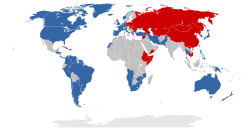Three-world model
Early in the Cold War era, NATO and the Warsaw Pact were created by the United States and the Soviet Union, respectively.
[5] In 1952, the French demographer Alfred Sauvy coined the term Third World in reference to the three estates in pre-revolutionary France.
Just as the third estate comprised everybody else, Sauvy called the Third World all the countries that were not in this Cold War division, i.e., the unaligned and uninvolved states in the "East–West Conflict.
"[6][4] The Third World countries are often described as developing nations with diverse economic, social, and political conditions.
The fourth world refers to "nations," e.g., cultural entities and ethnic groups, of indigenous people who do not compose states in the traditional sense.
